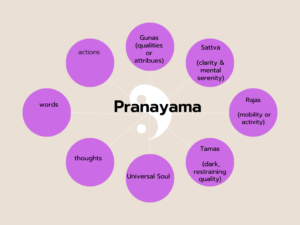The 8 limbs of yoga, also known as Ashtanga yoga, is a system of yoga outlined by the ancient sage Patanjali in his text the Yoga Sutras over 2000 years ago. He collected these he did not invent them.
By following the 8 limbs of yoga, it is said that a yogi can progress towards a holistic development of the physical, mental, and spiritual self, and cultivate inner peace and wisdom, ultimately leading to the ultimate goal of yoga, enlightenment.
The Eight Limbs
- Yama [ya-ma] observances of others
- Niyama [ni-ya-ma] self impose disciplines
- Asana [ah-sa-na] posture
- Pranayama [prah-nah-yah-ma] control of life force, breath
- Pratyahara [pra-tyah-hah-ra] withdrawal of the senses
- Dharana [d-hah-rah-na] concentration
- Dhyana [d-hee-ah-na] meditative absorption
- Samadhi [sam-ahd-hi] ecstasy

It’s important to note that the 8 limbs of yoga are not meant to be followed in a linear fashion but rather, they are interconnected and build upon each other, and one should strive to maintain the balance between all the 8 limbs of yoga.

Yama
The yamas are ethical guidelines for living and include non-violence (ahimsa), truthfulness (satya), non-stealing (asteya), and sexual restraint (brahmacharya).
These principles encourage living in a way that causes the least harm to yourself and others and promotes integrity, honesty, and respect for yourself and others.

Niyama
The niyamas are personal observances, and include self-discipline (tapas), self-study (svadhyaya), and surrender to a higher power (Ishvara pranidhana).
These principles encourage developing self-awareness, self-discipline, and a sense of connection to something greater than yourself.

Asana
Asanas are physical postures and yoga practices, which help to strengthen and tone the body, improve flexibility, and promote overall physical health.
Asanas are designed to prepare the body for the practice of the other limbs of yoga.

Pranayama
Pranayama is the control of the breath, which helps to regulate the flow of energy in the body. By controlling the breath, you can control the mind and emotions, and promote a sense of inner peace.

Pratyahara
Pratyahara is the withdrawal of the senses from external distractions, which helps to focus the mind on the inner self. By withdrawing the senses, you can develop a deeper awareness of yourself and find inner peace.

Dharana
Dharana is concentration, which involves focusing the mind on a single point or object. By developing concentration, you can control the mind and reduce distractions, which leads to inner peace.

Dhyana
Dhyana is meditation, which is a state of deep contemplation and absorption in the object of focus. Dhyana leads to a state of inner peace and a deeper understanding of yourself.

Samadhi
Samadhi is the state of enlightenment or union with the divine, characterized by a state of pure awareness and complete inner peace.
In this state, you experience a sense of oneness with all things, and the illusion of separation between the self and the divine is dissolved.

Yoga teachers learn this during their training but it’s often not taught in weekly classes – sometimes teachers mention it – I’ve written this as part of my own learning and wanted to share it – just in case you have an interest or I mention it during our lessons – you’ll have a little more background.
We end meditation and classes with Namaste which means
The Divine within me bows to the same Divine within you


